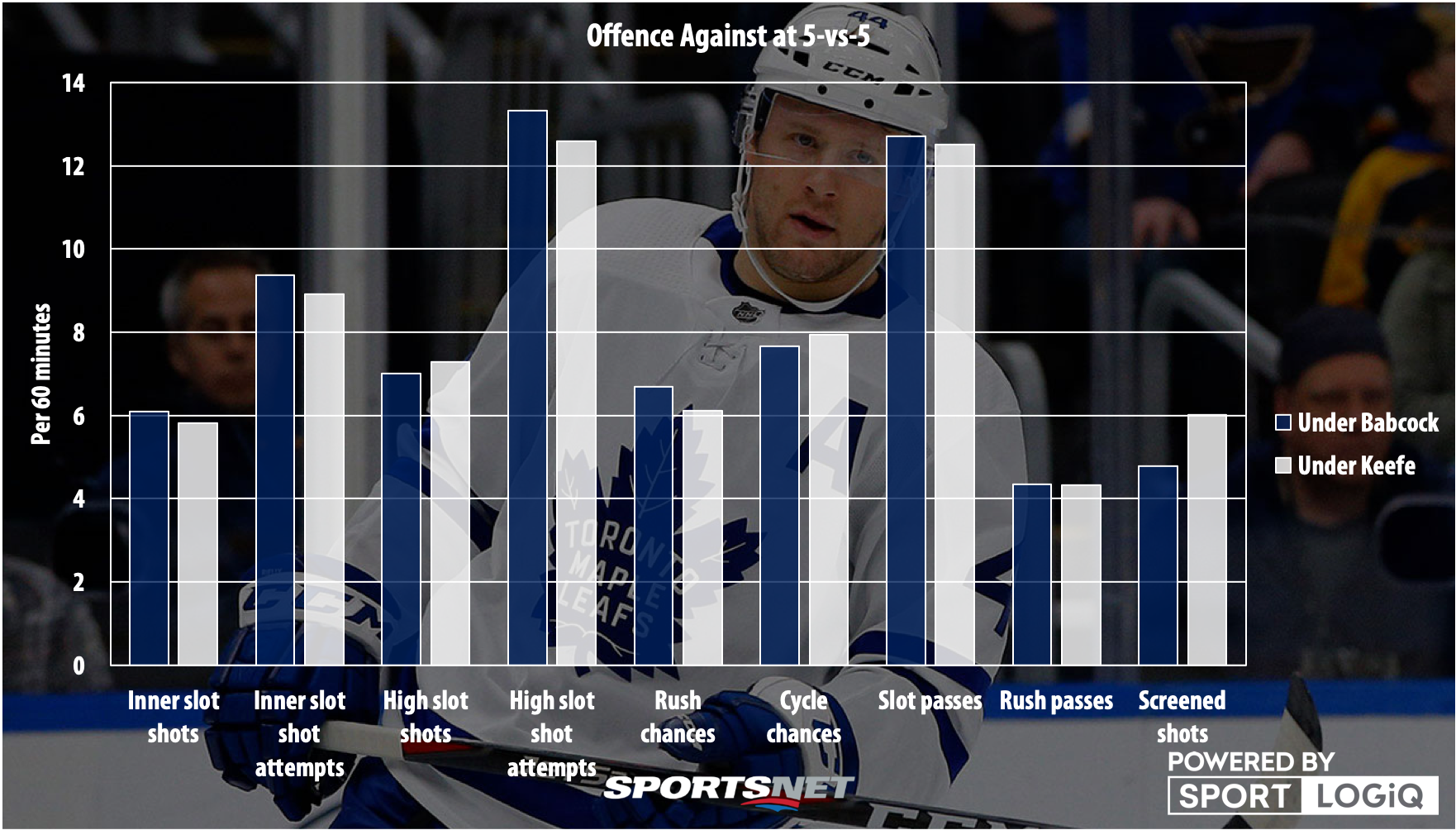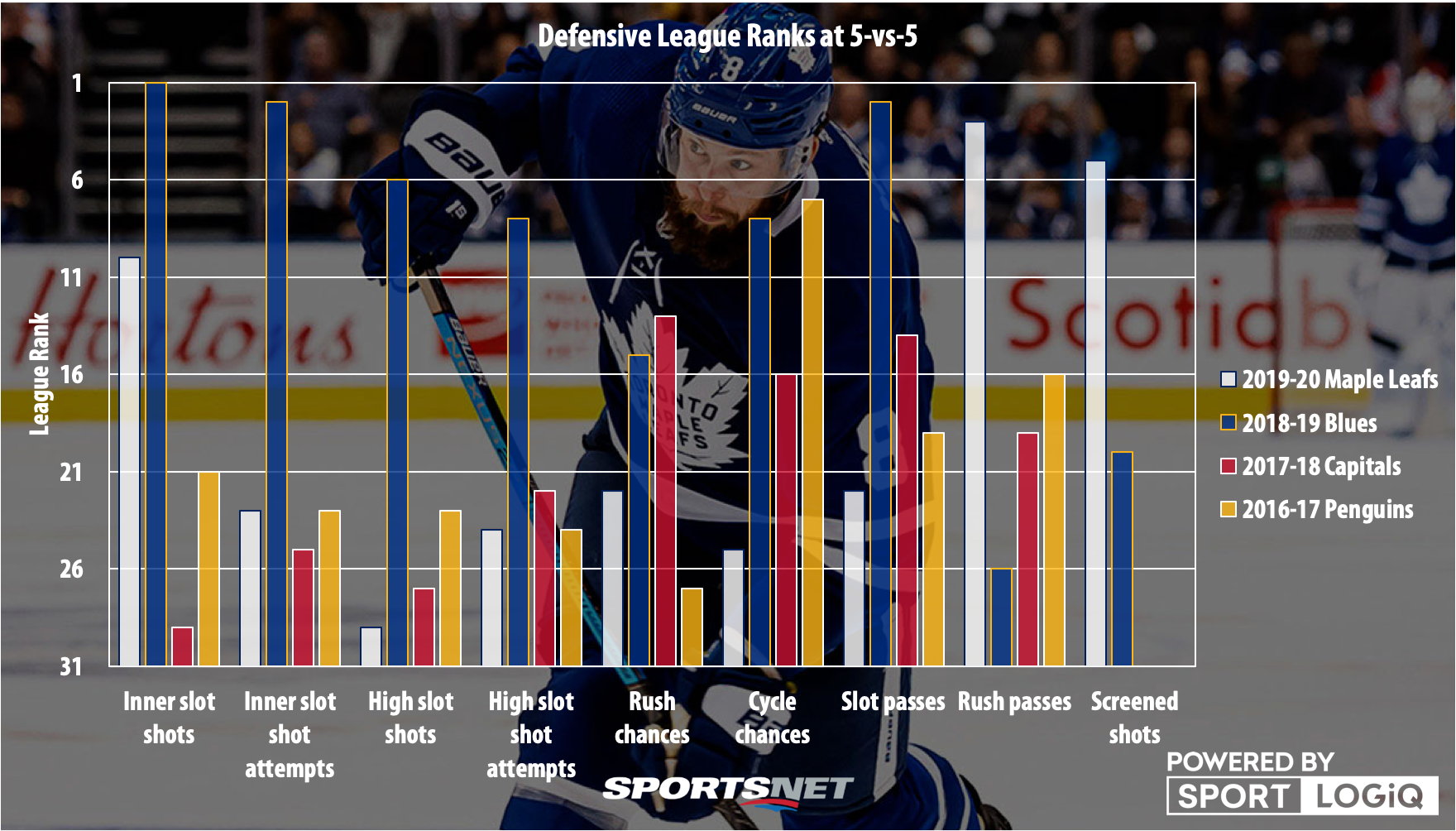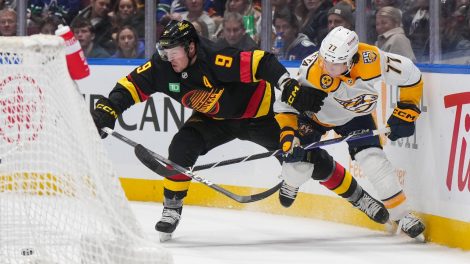Despite a 15-6-2 record since Sheldon Keefe took over as coach of the Toronto Maple Leafs, a string of three straight losses — punctuated by an 8-4 drubbing at the hands of the division rival Florida Panthers — has some feeling a little bit nervous about the way the Maple Leafs play defensively.
It’s been a very common refrain on sports talk radio for years now that the Leafs are going to have to change the way they play defensively in order to succeed in the playoffs. Hand wringing over who is on the blue line and the perceived lack of defensive talent there is always a talking point in Toronto.
Add to that Jake Muzzin and Morgan Rielly being put on the injured reserve and you’ve got a potential recipe for disaster if everyone is right about the Leafs trending down defensively.
[snippet id=4167285]
Toronto began this season significantly improved defensively over recent ones, but a slow start from Frederik Andersen and a huge drop off in offensive production from the team as a whole held them back until Mike Babcock was fired. With Keefe behind the bench, the floodgates opened, the creativity began to flow, and the Leafs have once again been one of the league’s most dangerous offensive teams.
The way things work in hockey, though, sometimes when you push the play offensively to an extreme level, you’re going to make a trade off defensively, because there is more inherent risk in making dynamic, creative plays. So, is Keefe’s more freewheeling approach to the Leafs’ offensive game bringing about an equal but opposite reaction in his own zone?
To find out, we can look at how the Leafs performed defensively under Babcock compared to how they’ve played since the coaching change.

For the most part, things haven’t changed defensively under Keefe. Taking the good things that Babcock had implemented this year, a little more effort and a few little tweaks has resulted in a slightly better overall process for the Leafs in their own zone.
Shots and shot attempts from the slot area are down slightly, although shots on net from the high slot are up, while attempts are down. That fits with the slight increase in cycle chances against, since the high slot area is mostly where the cycle produces chances from — it’s tough to penetrate the net front with a pass due to the extra defensive focus, less space, and the goalie being an extra option to block a pass across.
Off the rush, the Leafs are giving up a bit less, though they haven’t really chipped away much at completed pass off the rush, or at passes to the slot.
The one area where there seems to be a somewhat significant change for the Leafs on defence is in the number of screened shots they’re allowing on net, which has jumped up by over 25 per cent under Keefe.
My first instinct upon seeing this was to wonder if the Leafs had shifted to more of a fronting-style defence in front of Andersen and were getting in his way more on dangerous shots, but not blocking them, which would factor into why his save percentage has dropped of late.
So I asked Steve Dangle if that was true, then looked at some video as well.
Steve didn’t think that was the case, and mentioned the forwards jump up more to cover the points now, so I broke down the screened shot data a little bit more, and looked at some more video.
While on the surface it may look bad that the Leafs are giving up more screened shots than before, they’re actually giving up fewer screened shots from the slot; 1.17 per 60 minutes compared to 1.52 under Babcock. That area would be the most vulnerable if the Leafs were fronting but failing to block shots, and they’re clearly not doing that.
The biggest difference has been on point shots, where the Leafs are giving up 3.98 screened shots against per 60 minutes under Keefe compared to 2.5 under Babcock, which makes sense considering what Steve said about forwards being more aggressive with point shooters.
Under Babcock, the Leafs played the points relatively conservatively in their own zone, giving them a bit of time and space since that area isn’t very dangerous to shoot from – and instead prioritized defensive positioning within the lower half of the zone.
When a team is very good defensively, that can force opponents to shoot more from the perimeter in hopes of just getting pucks through, which actually renders them far less effective. But teams just took advantage of the time and space Toronto was giving them under Babcock and set up better plays; the Leafs allowed the fourth-fewest shot attempts in the league from the perimeter under Babcock, while 39 per cent of their total shot attempts against came from the slot, which ranked 30th.
Under Keefe, the shot attempts against from the perimeter have increased — the Leafs allow the 10th-fewest now, as attackers put more pressure on point shooters to force them to make decisions quicker, leaving opponents simply having to throw the puck at the net more often. That has in turn cut down the portion of shot attempts the Leafs allow from the slot to 36.5 per cent, which still isn’t great at 22nd-best in the league, but is clearly an improvement.
There’s a give and take with every strategic decision in hockey, and more aggression at the blue line means more forwards taking away the goaltender’s view of the puck on those shots. But, interestingly, the Leafs are blocking fewer shots from the slot than they were under Babcock.
Based on the data and watching some video, my conclusion is that Keefe’s philosophy is being aggressive up high forces bad decisions, and sometimes those bad decisions can end up in an odd-man rush for your team. Meanwhile, when the puck is in the slot, it’s more important for the goaltender to see it clearly than it is for a defender to get in the way.
[snippet ID=3322139]
For the most part these aren’t large scale changes, but overall I would say they’re good ones, and the net effect is a positive one. It’s just that Andersen hasn’t been great lately, and the team is still prone to isolated individual mistakes from time to time.
However, comparing them against themselves doesn’t tell the whole story, because in the end the question is whether the Leafs’ defensive personnel and strategies are good enough to win in the playoffs. So across the whole season so far where do they rank as a defensive team and how does it compare to previous Stanley Cup winners?

Not all the metrics I used are available for other years — specifically screened shots aren’t available beyond last season — but across the various defensive metrics we can see that the St. Louis Blues were a defensive powerhouse. They were a terrifying team to attempt to create offence against last season. Not that they were without weakness (they were a below league average team at defending off the rush) but on balance they were incredible at keeping the puck out of dangerous areas.
Because this league has a short memory, the way the Blues won the Stanley Cup last season looms incredibly large in the minds of fans and media. After all, how could anyone hope to beat a team like the Blues with the relatively shoddy league ranks the Leafs have put up defensively? They’re incredibly porous from the high slot and off the cycle especially.
But then you go back two years, and three years, and you can see that the Capitals of 2017-18 and Penguins of 2016-17 were no great shakes defensively either. Both teams were better at stopping cycle chances by a significant margin, and better at stopping slot passes too, but the Leafs have been better at their net front.
If we go back to 2015-16, I don’t have access to data for rush and cycle chances so I kept it off the graphic, but the Penguins’ first Cup win of their back-to-back victories looked much closer to the Blues defensively: they were seventh, fifth, seventh, and fifth at controlling inner slot shots and attempts, and high slot shots and attempts. They allowed the sixth-fewest slot passes as well.
Being defensively proficient is absolutely a help to get to the promised land, but going through the past four Cup winners we have two whose average league rank across these metrics is around ninth, and two around 20, while the Maple Leafs’ average comes out to 18.
Not all areas are equal here, and the Leafs should certainly strive to improve their defensive structure in the high slot, but anyone who says only great defensive teams can win in the playoffs is selling you false information.
[relatedlinks]







